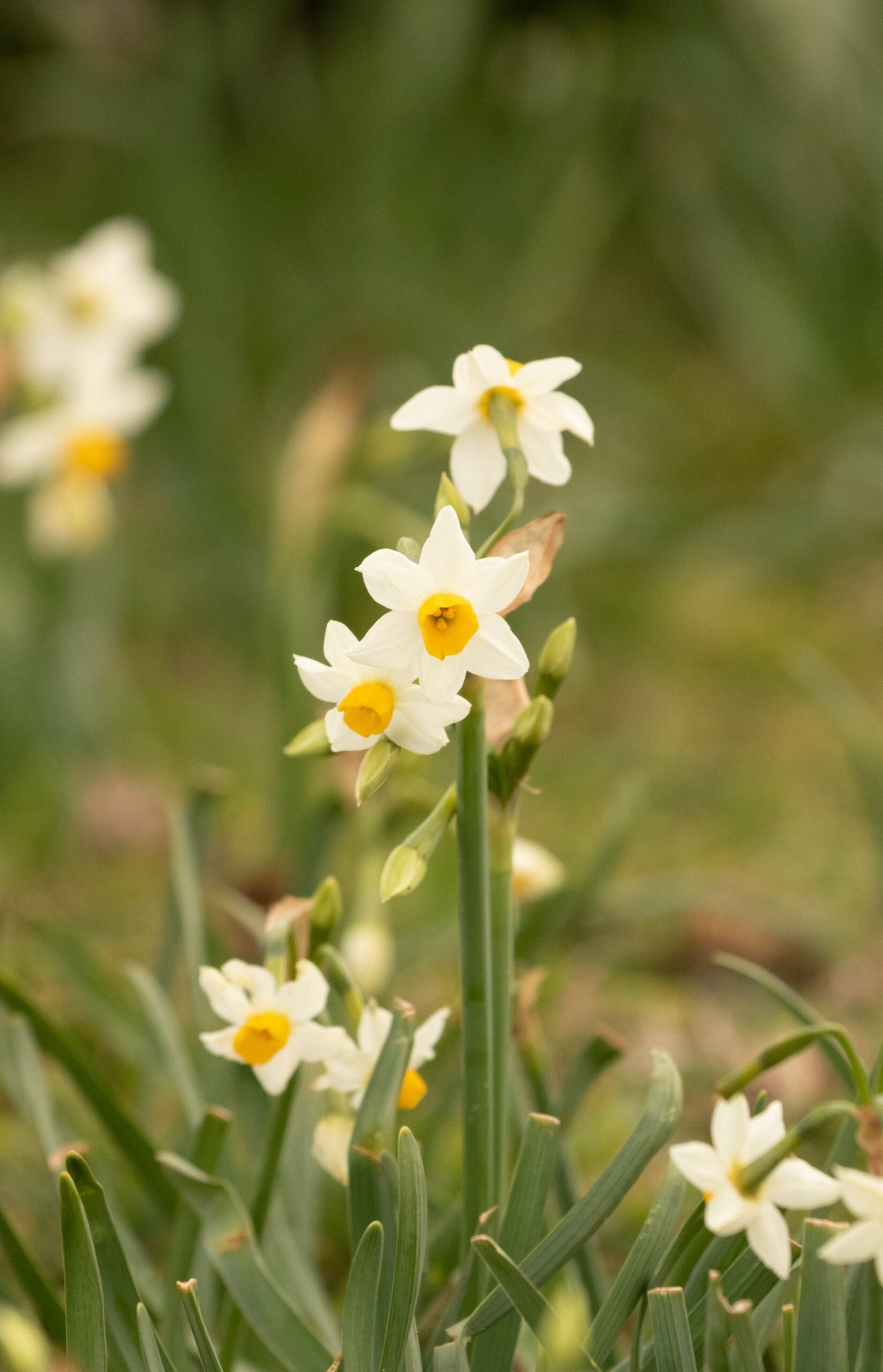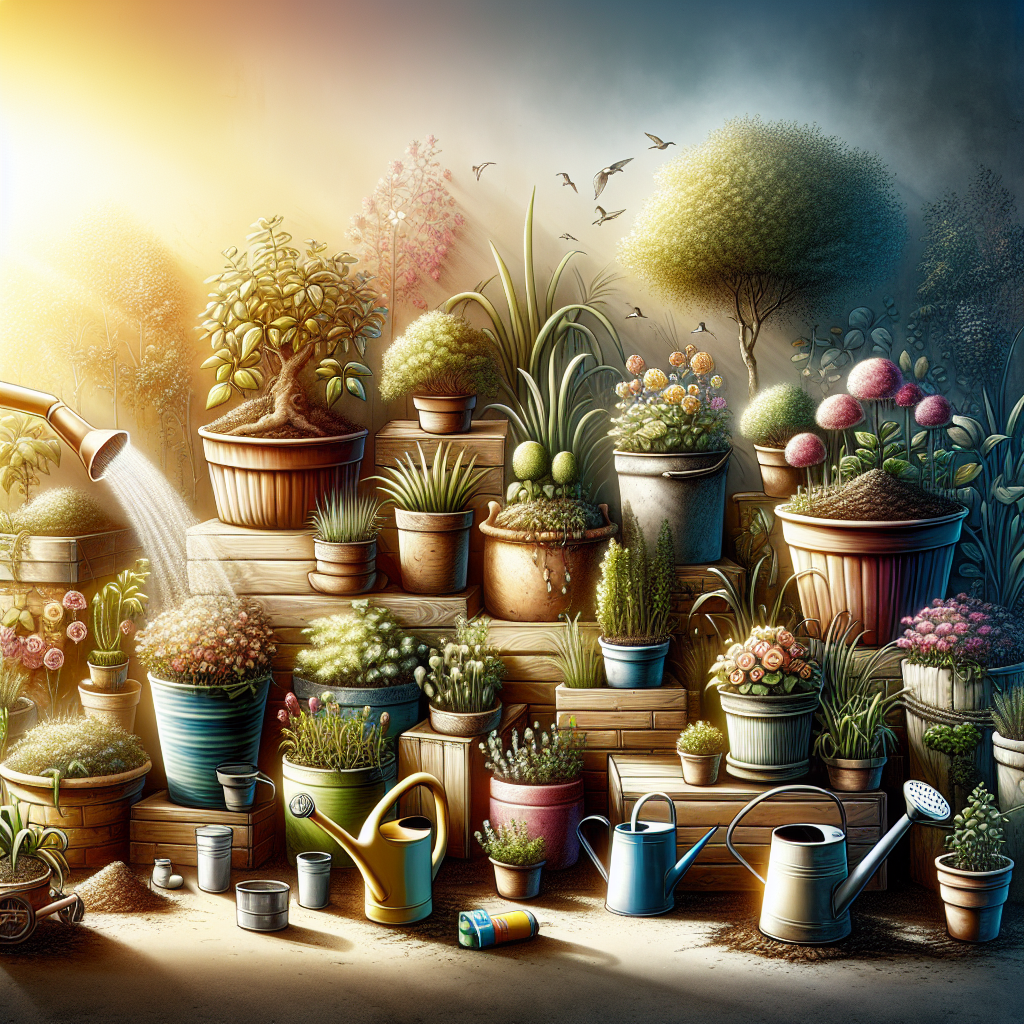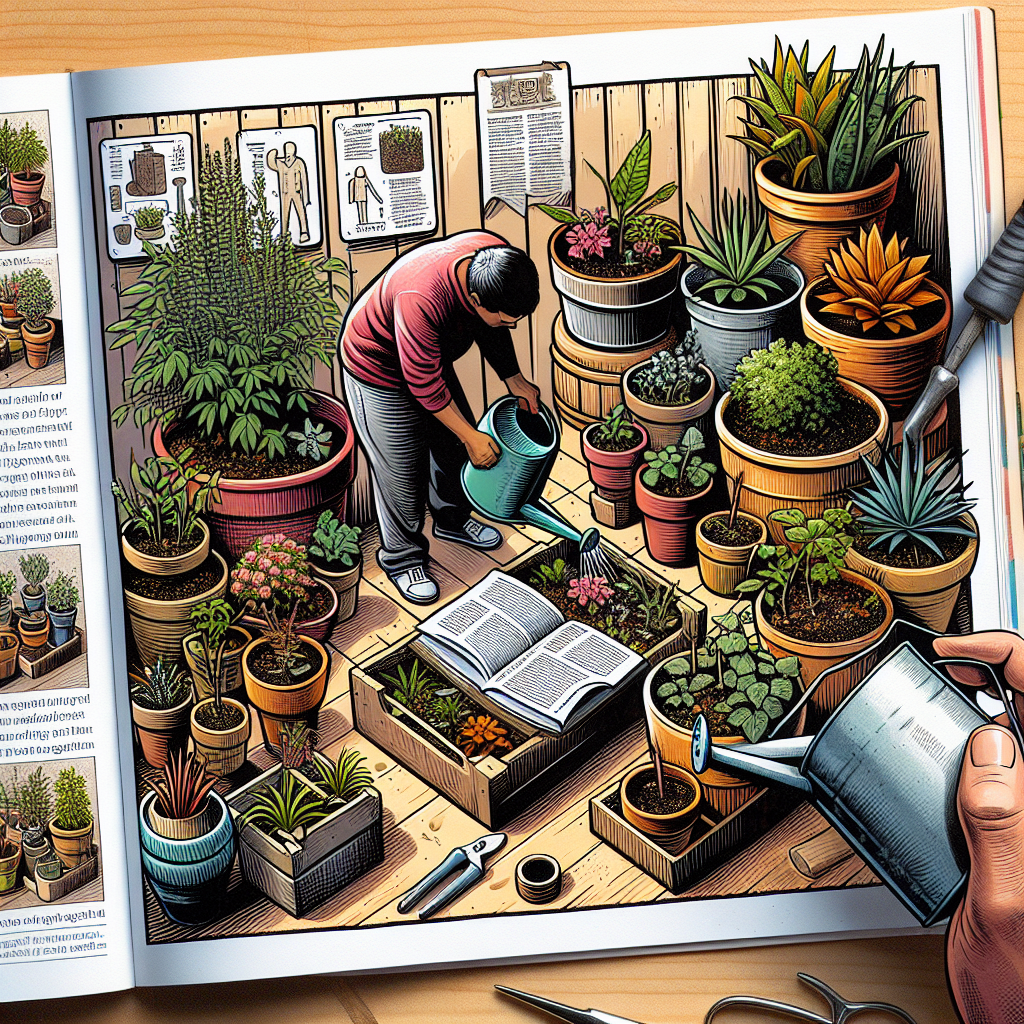
Are you interested in starting a garden but don’t have a large outdoor space? Look no further than container gardening! Whether you have a small balcony or a limited backyard, container gardening is a great way to grow plants in South Africa. In this article, we will explore 5 easy steps to help you create a successful container garden. From choosing the right plants to maintaining proper care, you will be on your way to enjoying a beautiful and thriving garden in no time.

Choosing the Right Containers
Consider the size and depth of the container
When it comes to container gardening, selecting the right size and depth for your containers is essential. The size of the container will determine how many plants you can fit in it, while the depth will determine the types of plants that can thrive. For larger plants with deep roots, such as tomatoes or peppers, opt for containers that are at least 12-18 inches deep. On the other hand, if you’re planning to grow herbs or smaller flowers, containers that are 6-8 inches deep will suffice.
Opt for containers with good drainage
Proper drainage is crucial for the health of your plants. Choose containers that have drainage holes at the bottom to prevent water from pooling and causing root rot. If you have your heart set on a beautiful container without drainage holes, you can create your own by drilling holes in the bottom. Additionally, consider using a saucer or tray underneath your containers to catch excess water and prevent it from causing damage to your patio or balcony.
Select containers that are durable and weather-resistant
Containers for container gardening should be able to withstand various weather conditions, especially in South Africa where temperatures can range from scorching hot to chilly. Opt for containers made from materials like plastic, ceramic, or concrete, which are known for their durability. Avoid containers made from materials that can break easily or are prone to rusting, as they won’t last in the long run. Remember, investing in quality containers will save you money and effort in the future.
Selecting the Ideal Plants
Determine the amount of sunlight available
Before selecting plants for your container garden, take the time to assess the amount of sunlight your chosen spot receives. Some plants thrive in full sun, while others prefer partial shade or even full shade. Observe your chosen area throughout the day and note the length and intensity of sunlight it receives. This will help you select plants that will flourish in your specific conditions and ensure their overall health and productivity.
Choose native or adaptive plants
When it comes to container gardening in South Africa, it’s advisable to choose plants that are native or well-adapted to the local climate. Native plants are naturally suited to the local environment and are more likely to thrive with minimal care. Look for plants that are labeled as drought-tolerant or heat-tolerant, as these will be better able to withstand the often harsh conditions of South African summers. Additionally, consider selecting plants that attract pollinators, as they will help promote a healthy ecosystem in your container garden.
Consider the growth habits and space requirements of the plants
Different plants have different growth habits and requirements when it comes to spacing. Some plants, like trailing flowers or vining vegetables, require ample space to spread out and grow. On the other hand, some plants, like compact herbs or lettuce, can be grown closer together in smaller containers. Consider the mature size of your chosen plants and their spacing requirements to ensure they have enough room to thrive and reach their full potential. This will prevent overcrowding and competition for resources, ultimately leading to healthier and more productive plants.
Preparing the Container
Clean the container before planting
Before planting in a new container or reusing an existing one, it’s important to clean it thoroughly. Use a mixture of water and mild soap to remove any dirt or debris, and rinse it well to ensure no soap residue remains. Cleaning the container helps prevent the buildup of harmful pathogens or pests that can potentially harm your plants. Additionally, it ensures a clean, healthy environment for your plants to grow in.
Add drainage material at the bottom
To further improve drainage in your containers, consider adding a layer of drainage material at the bottom. This can be anything from small stones or pebbles to broken pottery pieces. The drainage material creates a barrier between the soil and the drainage holes, preventing the holes from becoming clogged and allowing excess water to flow freely. This simple step can greatly improve the overall health and longevity of your container garden.
Fill the container with suitable potting mix
Choosing the right potting mix is crucial for the success of your container garden. Avoid using garden soil, as it tends to be too dense and may not provide adequate drainage. Instead, opt for a high-quality potting mix specifically designed for containers. These mixes are lightweight, well-draining, and often enriched with nutrients that promote healthy plant growth. Fill your container with the potting mix, leaving enough room for the plants’ roots to spread out and establish themselves.
Planting and Watering
Plant the chosen plants with proper spacing
When it’s time to plant your chosen plants, be mindful of the proper spacing recommended for each plant. Crowding plants together can lead to competition for nutrients, inadequate air circulation, and increased susceptibility to pests and diseases. Refer to the plant tags or do some research to determine the appropriate spacing. Gently loosen the roots of the plants before placing them in the container and cover them with soil, ensuring they are firmly in place. Give each plant enough space to grow and develop properly.
Water the container regularly and deeply
Proper watering is essential for the health and vitality of your container garden. Container plants often require more frequent watering than plants in the ground, as they can dry out quickly. Check the moisture level of the soil regularly by sticking your finger about an inch into the soil. If it feels dry, it’s time to water. When watering, aim to saturate the entire root zone, allowing the water to penetrate deeply. Avoid shallow watering, as it encourages shallow root growth and makes the plants more susceptible to drying out.
Mulch the soil surface to conserve moisture
Mulching the soil surface is a simple yet effective way to conserve moisture in your container garden. Apply a layer of organic mulch, such as wood chips or straw, around the base of your plants. The mulch acts as a protective barrier, reducing evaporation and regulating soil temperature. It also helps suppress weed growth and adds organic matter to the soil as it breaks down. Mulching not only conserves water but also saves you time and effort in the long run by reducing the need for frequent watering.

Providing Adequate Care
Fertilize the plants as needed
To ensure your container plants receive the necessary nutrients, it’s important to fertilize them regularly. Container-grown plants often deplete nutrients more quickly than those in the ground. Choose a balanced, slow-release fertilizer specifically formulated for container plants. Follow the instructions on the fertilizer package to determine the appropriate amount and frequency of application. Over-fertilizing can lead to nutrient burn and other issues, so it’s better to err on the side of caution and start with a smaller amount.
Monitor for pests and diseases
Pests and diseases can quickly derail the health and productivity of your container garden. Regularly inspect your plants for any signs of pest damage, such as chewed leaves or discolored spots. Keep an eye out for common pests like aphids, mealybugs, or spider mites, and take appropriate action if you spot any. Similarly, watch for signs of diseases such as fungal infections or wilting. Promptly address any issues you encounter to prevent them from spreading and causing further damage.
Prune and deadhead plants to maintain their shape and encourage growth
Pruning and deadheading are important maintenance tasks that help keep your container garden looking tidy and promote healthy growth. Pruning involves removing any dead, damaged, or overgrown branches or stems. Deadheading, on the other hand, involves removing spent flowers to encourage the growth of new blooms. Both practices help improve airflow, reduce disease risks, and direct the plant’s energy towards new growth. Regularly inspect your plants and use clean, sharp pruners or shears to make clean cuts.
Dealing with Climate Challenges
Protect containers from extreme heat or cold
In South Africa, extreme temperature fluctuations can pose challenges for container gardening. During periods of scorching heat, it’s important to protect your containers from direct sunlight, as excessive heat can damage and dry out the plants. Move containers to a shaded area or provide some form of shade, such as using a patio umbrella or shade cloth. Similarly, during cold spells, insulate your containers by wrapping them with horticultural fleece or moving them to a sheltered spot to prevent damage from frost.
Provide shade or shelter during intense sun or hailstorms
Intense sun or hailstorms can be particularly damaging to container plants. If you anticipate extreme weather conditions, provide temporary shade or shelter for your containers. This can be achieved by using shade cloth, placing containers under a pergola or awning, or even bringing them indoors temporarily. Shielding your plants from direct sunlight or hail can prevent sunburn or physical damage to leaves, ensuring their continued health and productivity.
Water plants more frequently during hot and dry periods
Hot and dry periods can quickly deplete the moisture levels in your container garden. To prevent your plants from drying out, increase the frequency of watering during these periods. Check the moisture level of the soil regularly and adjust your watering schedule accordingly. It’s better to water deeply and less frequently rather than giving shallow, frequent waterings. Remember to water in the early morning or evening to minimize evaporation and allow the plants to absorb the moisture efficiently.

Harvesting and Enjoying the Fruits of Your Labor
Harvest vegetables and herbs when they are at their peak
One of the joys of container gardening is being able to enjoy the fruits of your labor. When it comes to harvesting vegetables and herbs, timing is crucial. Different plants have different harvesting periods, so it’s important to do some research to determine when your specific plants are at their peak. Harvest vegetables when they are fully ripe but before they become overripe or start to deteriorate. For herbs, harvest them when the leaves are fresh and fragrant, which is usually in the morning after any dew has dried.
Enjoy the beauty and fragrance of flowers
Container gardening is not just about growing food; it’s also about creating beautiful spaces and enjoying the wonders of nature. Choose flowering plants that not only add color but also emit enchanting fragrances. Consider planting varieties such as roses, lavender, or jasmine, which are known for their delightful scents. Place your flower-filled containers strategically around your patio or garden, allowing their beauty and fragrance to uplift your spirits and create a peaceful and inviting atmosphere.
Share your container garden’s bounty with others
Container gardening can often yield an abundance of fresh produce and beautiful flowers. As you enjoy the fruits of your labor, consider sharing the bounty with others. Whether it’s homemade meals made with your homegrown ingredients or cut flowers arranged into bouquets, sharing with friends, family, or even local community organizations can bring joy and foster a sense of community. Spread the love and the benefits of container gardening by sharing the fruits of your labor with those around you.
Troubleshooting Common Issues
Identify and address nutrient deficiencies
Nutrient deficiencies can cause a range of issues in container plants, from stunted growth to wilting leaves. By learning to identify common nutrient deficiencies, you can take appropriate action to address them. Look for signs such as yellowing leaves (indicating nitrogen deficiency), poor fruit formation (indicating potassium deficiency), or pale-colored leaves (indicating iron deficiency). Add organic or slow-release fertilizers specific to the nutrient deficiency, and adjust your fertilization schedule accordingly. Regular monitoring and timely intervention can help prevent nutrient-related issues in your container garden.
Treat common pests and diseases
Pests and diseases can wreak havoc on your container plants if left unchecked. Keep an eye out for signs of common pests such as aphids, whiteflies, or snails. If you spot any pests, promptly treat them with organic pest control methods like insecticidal soap, neem oil, or homemade remedies. Similarly, stay vigilant for signs of diseases such as powdery mildew or black spot. Treat infected plants with appropriate organic fungicides or use cultural practices like proper spacing and good ventilation to prevent the spread of diseases within your container garden.
Revive stressed or unhealthy plants
Even with proper care, container plants can sometimes become stressed or show signs of decline. If you notice your plants looking unhealthy or struggling, take proactive steps to revive them. First, assess the cause of the stress. It could be due to overwatering, underwatering, nutrient deficiencies, or environmental factors. Once you identify the cause, adjust your care routine accordingly. Prune away any dead or dying parts, refresh the potting mix if necessary, and give the plants some time and care to recover. With patience and proper care, most stressed or unhealthy plants can bounce back and thrive once again.

Exploring Container Gardening Innovations
Consider hydroponic or aquaponic container gardening
If you’re looking to take your container gardening to the next level, consider exploring hydroponic or aquaponic gardening techniques. Hydroponic gardening involves growing plants in nutrient-rich water, without the need for soil. Aquaponic gardening takes it a step further by incorporating fish into the system, where their waste provides nutrients for the plants. These methods can be particularly useful in areas with limited space or poor soil quality. Research and experiment with these innovative techniques to maximize your yield and explore new possibilities in container gardening.
Experiment with vertical gardening techniques
Vertical gardening is a fantastic way to make the most of limited space and add a unique aesthetic to your container garden. By growing plants vertically on trellises, walls, or hanging baskets, you can fit more plants in a smaller area. Vining plants such as tomatoes, cucumbers, or beans are ideal candidates for vertical gardening. Explore different trellis designs and hanging systems that suit your space and preferences. Vertical gardening not only increases your yield but also adds visual interest and dimension to your container garden.
Use self-watering or automated systems for convenience
For those with busy schedules or frequent travelers, self-watering or automated systems can be a game-changer in container gardening. Self-watering containers have built-in reservoirs that provide a steady supply of water to the plants, reducing the need for frequent watering. Automated irrigation systems can be set up to deliver water at specific intervals, ensuring your plants receive consistent moisture even when you’re not around. Explore the various options available and choose a system that suits your needs and lifestyle. These innovations can make container gardening more manageable and less time-consuming.
Connecting with the Container Gardening Community
Join local gardening clubs or organizations
Container gardening can be a delightful and fulfilling hobby, but it’s even more enjoyable when shared with others who share the same passion. Look for local gardening clubs or organizations in your area and consider joining them. These groups often offer a wealth of knowledge, resources, and support to help you grow as a container gardener. Participate in group activities, attend workshops or seminars, and interact with fellow gardeners to expand your knowledge, exchange ideas, and make new friends who share your love for container gardening.
Attend container gardening workshops and events
Container gardening workshops and events are great opportunities to learn new techniques, discover the latest trends, and deepen your understanding of this gardening method. Keep an eye out for local gardening centers, botanical gardens, or horticultural institutions that offer workshops or events specifically focused on container gardening. These events often feature expert speakers, hands-on demonstrations, and the chance to network with other like-minded individuals. Embrace these learning opportunities to enhance your skills and gain inspiration for your own container garden.
Share your experiences and learn from others
As you embark on your container gardening journey, don’t shy away from sharing your experiences and learning from others. Engage with fellow gardeners, both online and offline, through platforms like social media, gardening forums, or community gardening groups. Share your successes, challenges, and tips, and be open to receiving advice and feedback from others. Container gardening is a continuous learning process, and by connecting with the container gardening community, you will broaden your horizons, gain new perspectives, and become part of a supportive and vibrant gardening network.
In conclusion, container gardening in South Africa offers a world of possibilities for those wanting to cultivate plants in limited spaces or overcome challenges posed by poor soil. By choosing the right containers, selecting suitable plants, preparing the containers properly, and providing adequate care, you can create a thriving container garden that beautifies your surroundings and provides you with fresh produce and fragrant flowers to enjoy. Don’t be afraid to explore innovative techniques, troubleshoot common issues, and connect with fellow container gardeners to enhance your skills and expand your horizons. So go ahead, grab your containers, and embark on an exciting container gardening adventure. Happy gardening!






